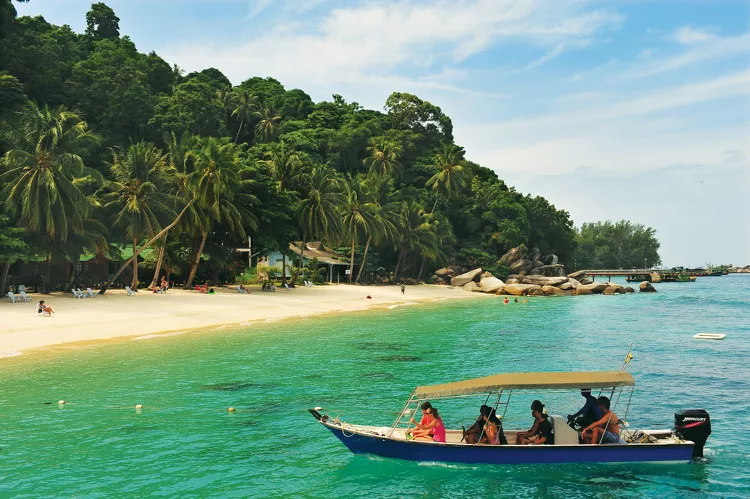Summary
Explore the Perhentian Islands: A Tropical Paradise
Perhentian means “place to stop” in Bahasa Malay, the language of Malaysia; the Perhentian Islands’ crystalline blue waters teeming with aquatic life will captivate you.
Easily accessible from the northeast coast, the Perhentian Islands are regarded as Malaysia’s crown jewel. With affordable scuba diving, picturesque beaches, and an inviting island lifestyle, visitors often leave with lasting memories of the soft white sands.
Two islands form the heart of Pulau Perhentian, each possessing unique characteristics and loyal followers. Perhentian Kecil, known as the small island, attracts backpackers and budget travelers, while the larger Perhentian Besar entices a more mature, resort-oriented audience.
Visiting the Perhentian Islands
While tourism is the heartbeat of Pulau Perhentian, the islands maintain their rugged, jungle charm. Structures are limited to two stories, motorized vehicles are absent, and electricity is often provided by intermittent generators, leaving you in the dark unexpectedly.
Infrastructure is minimal; the main attractions involve soaking up the sun and enjoying the sea.
- Internet access is limited and costly; internet cafes charge about US $5 per hour.
- No call centers exist, yet mobile networks function in certain areas.
- Monitor lizards wander the island; these beasts are not Komodo Dragons like those found elsewhere.
Important Note: There are no banks or ATMs, and theft in guest houses on Perhentian Kecil is known to occur, so visitors should bring ample cash.
Accommodation in the Perhentian Islands. Options range from budget to mid-range, with the Perhentian Island Resort at the upscale end. Consider exploring your options for lodging online.

Perhentian Kecil
Perhentian Kecil stands as the livelier and more bustling of the two islands. It draws backpackers from around the globe, and during peak season, accommodations often fill up rapidly; it is not uncommon to see people sleeping on the beach while waiting for a room.
This smaller island features two main beaches: Long Beach, which is known for its vibrant nightlife and accommodations, and Coral Bay, which offers a more laid-back atmosphere and lower prices. Beautiful sunsets can be viewed from Coral Bay, but many visitors prefer to socialize back at Long Beach.
The two beaches are interconnected by a jungle path, which takes about 15 minutes to traverse.
Perhentian Besar
Also known as “the big island,” Perhentian Besar caters more to families, couples, and those with higher budgets. This island is notably quieter and more relaxed compared to its counterpart, with luxury bungalows resembling small resorts featuring private bathrooms and air conditioning.
Perhentian Besar boasts three primary beach areas, with Teluk Dalam offering the most secluded stretch of pristine sand. “Love Beach,” known for its rocky terrain, serves as a popular gathering spot for social activities.
Diving the Perhentian Islands
Pulau Perhentian is part of a protected marine park where diving experiences are excellent and very affordable. Thanks to a turtle restoration initiative, an abundance of sea turtles and sharks can be found. Several dive shops across the islands offer PADI courses and fun dives, with prices starting at just US $25 per dive. Visibility often reaches around 20 meters during the dry season.
Snorkeling
Snorkeling gear can be rented from guesthouses and beach shacks for approximately $3 US per day. Visitors can partake in boat trips or simply venture into the water from the shore.
Perhentian Kecil: The prime snorkeling spots are located on the Coral Bay side. A path near the pier leads over rocks and through secluded coves, providing excellent snorkeling just offshore.
Perhentian Besar: The best snorkeling experiences can be found on the north and east sides of the island without the need for a boat.
Getting to the Perhentian Islands
Accessing Pulau Perhentian is most convenient through the small town of Kuala Besut. Two buses run daily, taking about nine hours to travel from Kuala Lumpur to Kuala Besut.
There are no direct bus services from Kota Bharu; travelers will need to switch to a local bus in either Jerteh or Pasir Puteh.
The speedboat ride from Kuala Besut to the Perhentian Islands can be quite thrilling, with the boats bouncing over waves, which may result in wet belongings. The larger boats only reach a point near the shore, transferring passengers and luggage to smaller wooden boats that take you onto the beach. For Perhentian Kecil, a fee of $1 US will be required from the boatmen, which is not included in the ticket price, so be ready to wade ashore.
When to Go
The optimal time to visit the Perhentian Islands is during the dry season from March to November. During the rainy months, the islands can appear almost deserted, as many businesses close down. Notably, July is considered peak season; thus, it’s advisable to secure accommodations in advance.





